

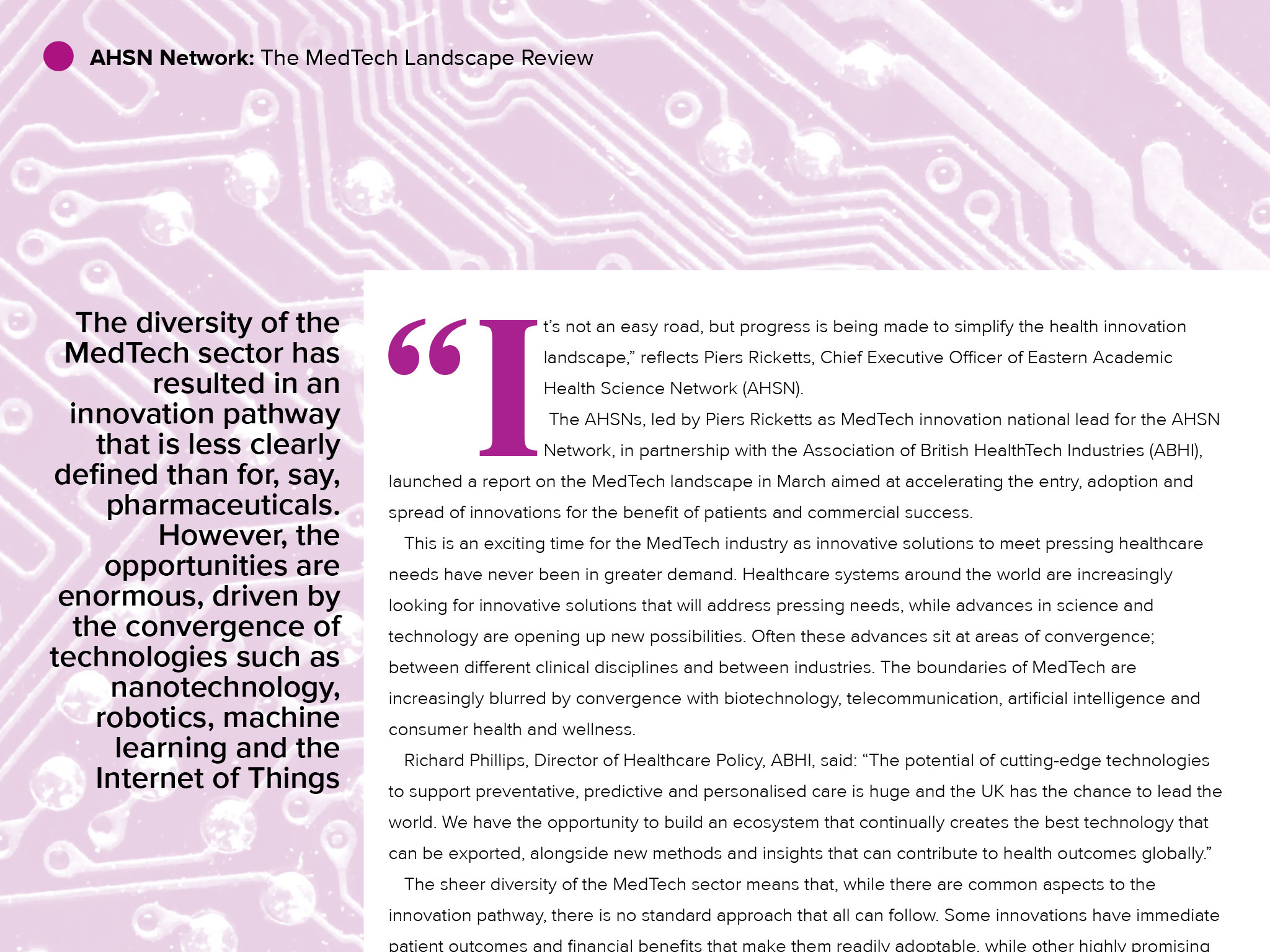
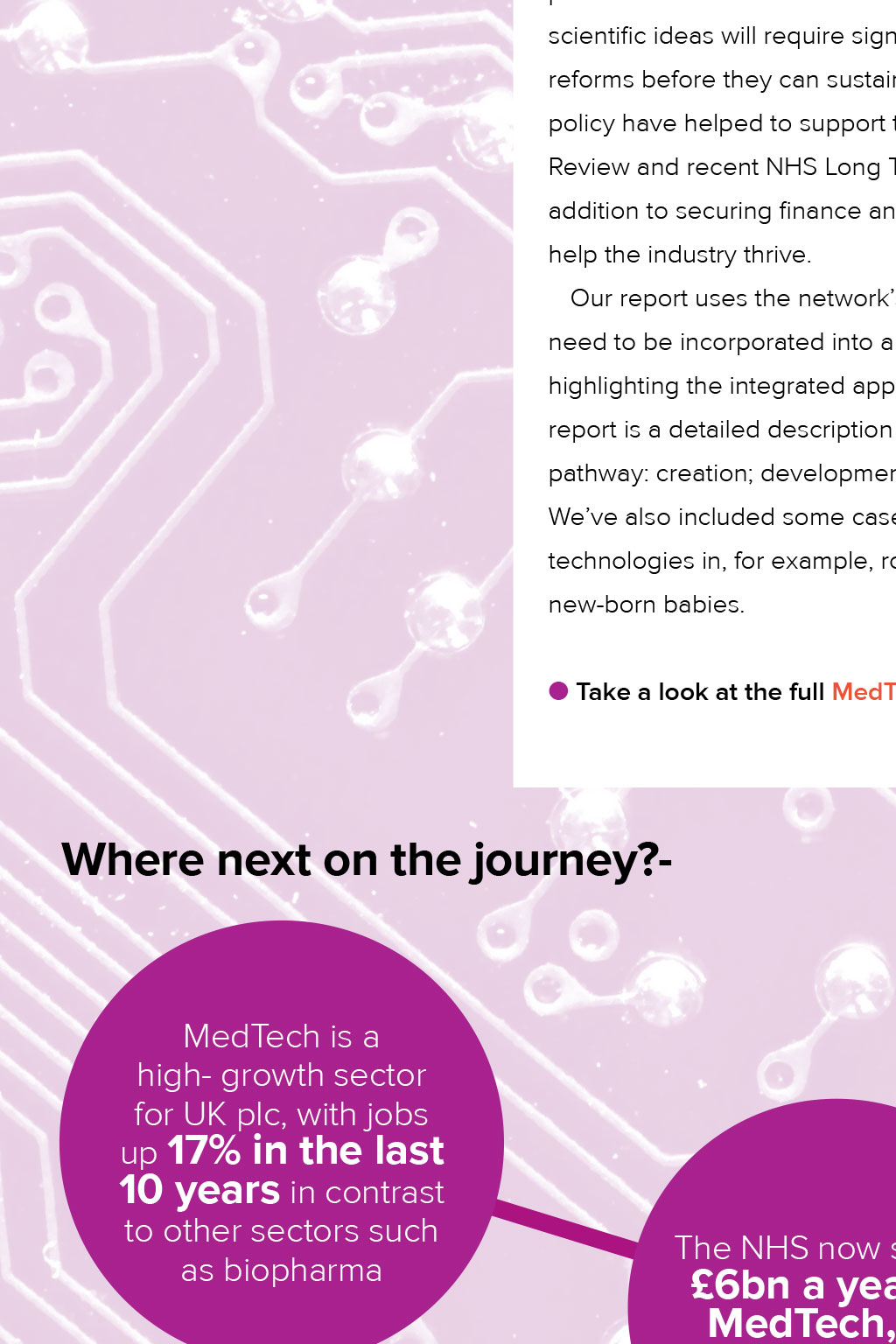
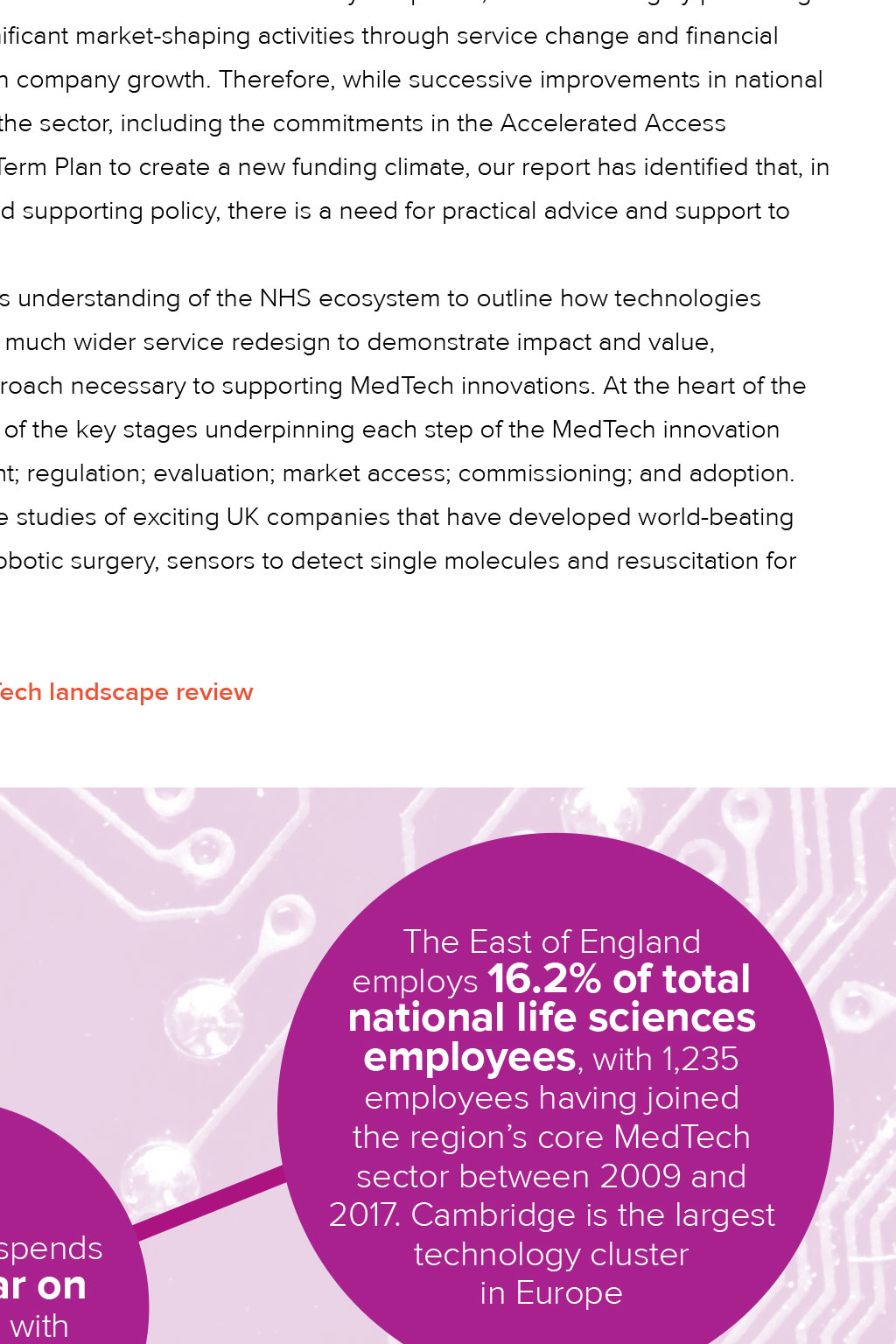
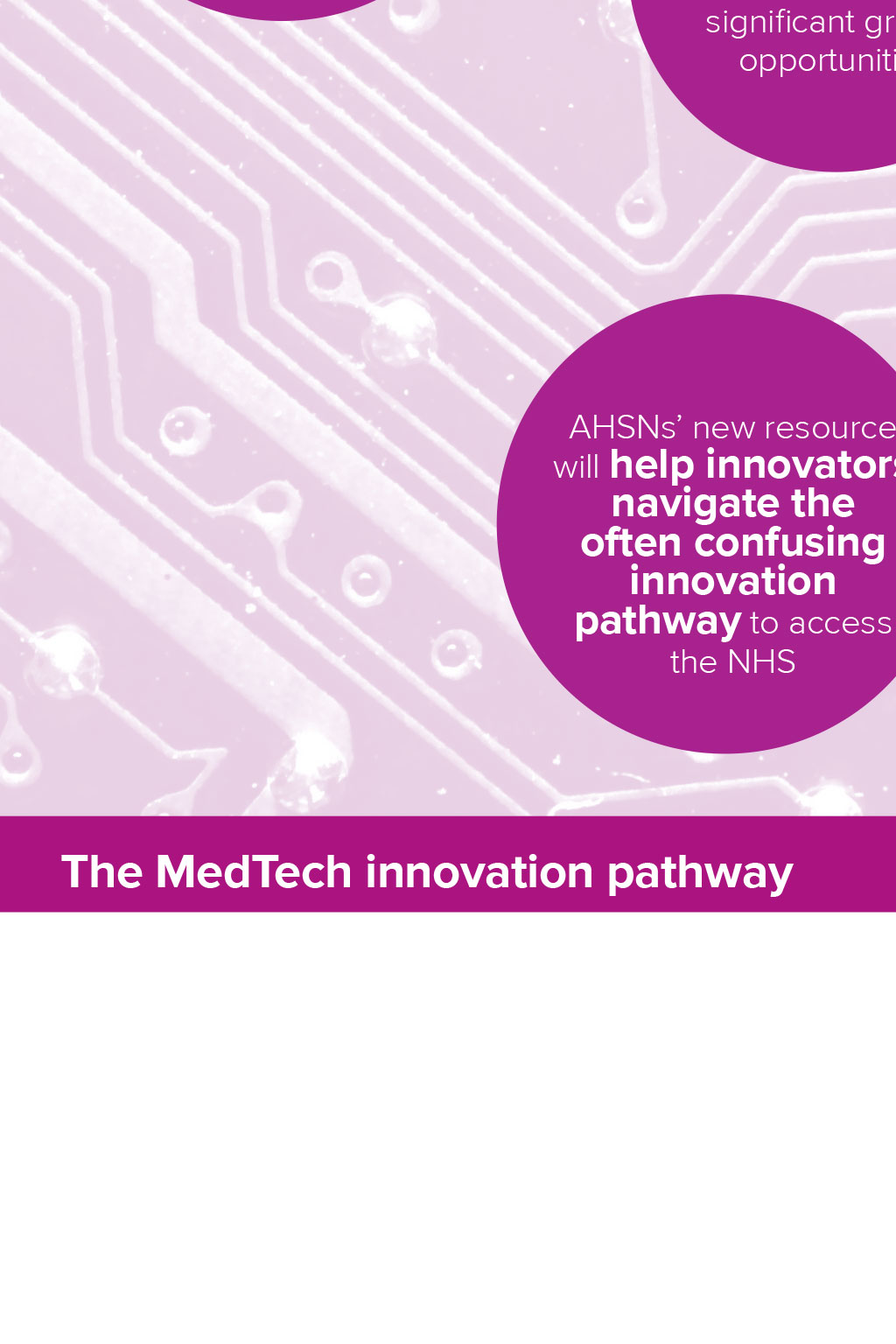
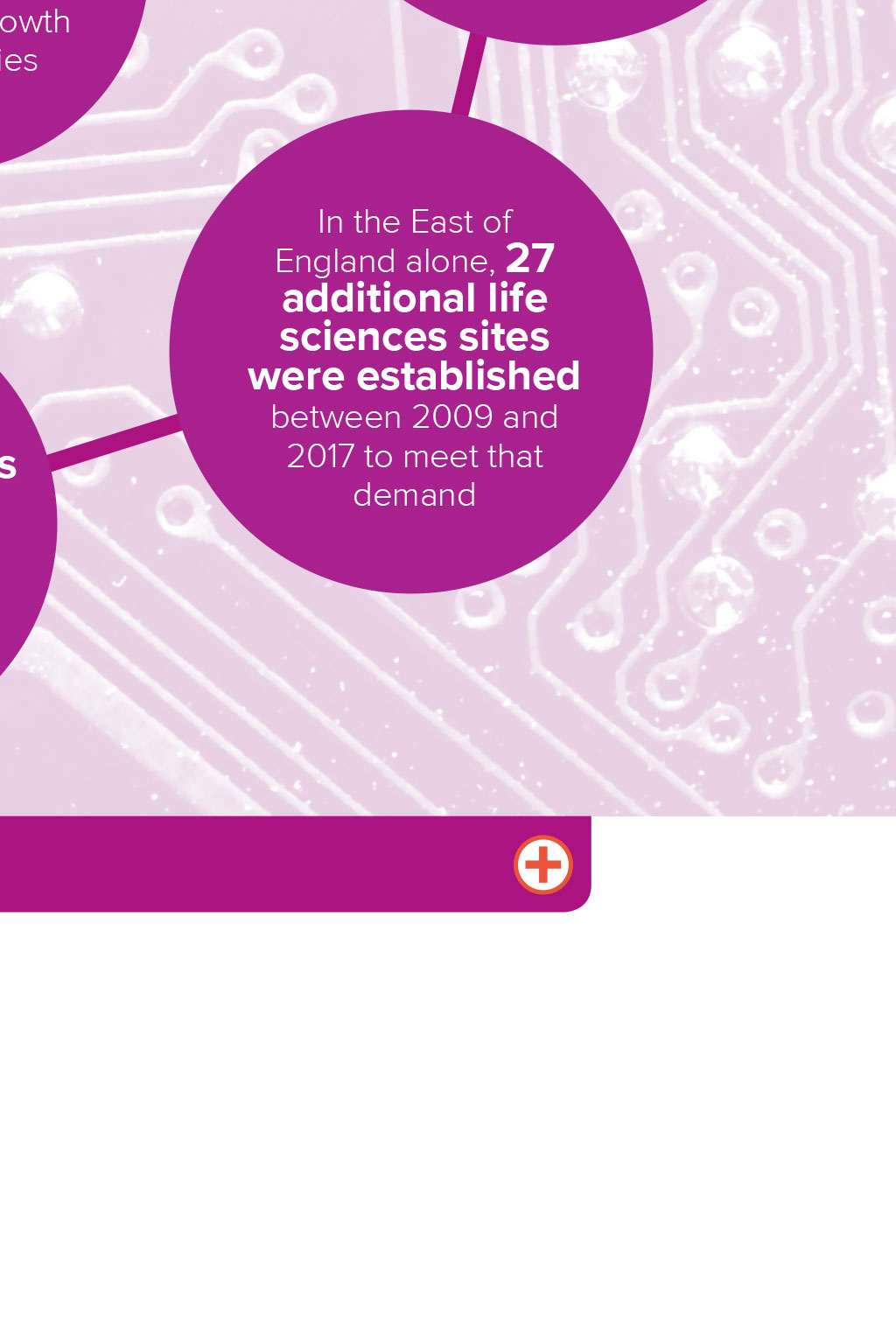












AHSN Network: The MedTech Landscape Review The Innovation Maze The diversity of the MedTech sector has resulted in an innovation pathway that is less clearly defined than for, say, pharmaceuticals. However, the opportunities are enormous, driven by the convergence of technologies such as nanotechnology, robotics, machine learning and the Internet of Things “It’s not an easy road, but progress is being made to simplify the health innovation landscape,” reflects Piers Ricketts, Chief Executive Officer of Eastern Academic Health Science Network (AHSN). The AHSNs, led by Piers Ricketts as MedTech innovation national lead for the AHSN Network, in partnership with the Association of British HealthTech Industries (ABHI), launched a report on the MedTech landscape in March aimed at accelerating the entry, adoption and spread of innovations for the benefit of patients and commercial success. This is an exciting time for the MedTech industry as innovative solutions to meet pressing healthcare needs have never been in greater demand. Healthcare systems around the world are increasingly looking for innovative solutions that will address pressing needs, while advances in science and technology are opening up new possibilities. Often these advances sit at areas of convergence; between different clinical disciplines and between industries. The boundaries of MedTech are increasingly blurred by convergence with biotechnology, telecommunication, artificial intelligence and consumer health and wellness. Richard Phillips, Director of Healthcare Policy, ABHI, said: “The potential of cutting-edge technologies to support preventative, predictive and personalised care is huge and the UK has the chance to lead the world. We have the opportunity to build an ecosystem that continually creates the best technology that can be exported, alongside new methods and insights that can contribute to health outcomes globally.” The sheer diversity of the MedTech sector means that, while there are common aspects to the innovation pathway, there is no standard approach that all can follow. Some innovations have immediate patient outcomes and financial benefits that make them readily adoptable, while other highly promising scientific ideas will require significant market-shaping activities through service change and financial reforms before they can sustain company growth. Therefore, while successive improvements in national policy have helped to support the sector, including the commitments in the Accelerated Access Review and recent NHS Long Term Plan to create a new funding climate, our report has identified that, in addition to securing finance and supporting policy, there is a need for practical advice and support to help the industry thrive. Our report uses the network’s understanding of the NHS ecosystem to outline how technologies need to be incorporated into a much wider service redesign to demonstrate impact and value, highlighting the integrated approach necessary to supporting MedTech innovations. At the heart of the report is a detailed description of the key stages underpinning each step of the MedTech innovation pathway: creation; development; regulation; evaluation; market access; commissioning; and adoption. We’ve also included some case studies of exciting UK companies that have developed world-beating technologies in, for example, robotic surgery, sensors to detect single molecules and resuscitation for new-born babies. Where next on the journey?- MedTech is a high- growth sector for UK plc, with jobs up 17% in the last 10 years in contrast to other sectors such as biopharma The NHS now spends The East of England employs 16.2% of total national life sciences employees, with 1,235 employees having joined the region’s core MedTech sector between 2009 and 2017. Cambridge is the largest technology cluster in Europe In the East of England alone, 27 additional life sciences sites were established between 2009 and 2017 to meet that demand ● Take a look at the full MedTech landscape review £6bn a year on MedTech, with significant growth opportunities AHSNs’ new resource will help innovators navigate the often confusing innovation pathway to access the NHS The MedTech innovation pathway AHSN Network: The MedTech Landscape Review The diversity of the MedTech sector has resulted in an innovation pathway that is less clearly defined than for, say, pharmaceuticals. However, the opportunities are enormous, driven by the convergence of technologies such as nanotechnology, robotics, machine learning and the Internet of Things “It’s not an easy road, but progress is being made to simplify the health innovation landscape,” reflects Piers Ricketts, Chief Executive Officer of Eastern Academic Health Science Network (AHSN). The AHSNs, led by Piers Ricketts as MedTech innovation national lead for the AHSN Network, in partnership with the Association of British HealthTech Industries (ABHI), launched a report on the MedTech landscape in March aimed at accelerating the entry, adoption and spread of innovations for the benefit of patients and commercial success. This is an exciting time for the MedTech industry as innovative solutions to meet pressing healthcare needs have never been in greater demand. Healthcare systems around the world are increasingly looking for innovative solutions that will address pressing needs, while advances in science and technology are opening up new possibilities. Often these advances sit at areas of convergence; between different clinical disciplines and between industries. The boundaries of MedTech are increasingly blurred by convergence with biotechnology, telecommunication, artificial intelligence and consumer health and wellness. Richard Phillips, Director of Healthcare Policy, ABHI, said: “The potential of cutting-edge technologies to support preventative, predictive and personalised care is huge and the UK has the chance to lead the world. We have the opportunity to build an ecosystem that continually creates the best technology that can be exported, alongside new methods and insights that can contribute to health outcomes globally.” The sheer diversity of the MedTech sector means that, while there are common aspects to the innovation pathway, there is no standard approach that all can follow. Some innovations have immediate patient outcomes and financial benefits that make them readily adoptable, while other highly promising scientific ideas will require significant market-shaping activities through service change and financial reforms before they can sustain company growth. Therefore, while successive improvements in national policy have helped to support the sector, including the commitments in the Accelerated Access Review and recent NHS Long Term Plan to create a new funding climate, our report has identified that, in addition to securing finance and supporting policy, there is a need for practical advice and support to help the industry thrive. Our report uses the network’s understanding of the NHS ecosystem to outline how technologies need to be incorporated into a much wider service redesign to demonstrate impact and value, highlighting the integrated approach necessary to supporting MedTech innovations. At the heart of the report is a detailed description of the key stages underpinning each step of the MedTech innovation pathway: creation; development; regulation; evaluation; market access; commissioning; and adoption. We’ve also included some case studies of exciting UK companies that have developed world-beating technologies in, for example, robotic surgery, sensors to detect single molecules and resuscitation for new-born babies. Where next on the journey?- MedTech is a high- growth sector for UK plc, with jobs up 17% in the last 10 years in contrast to other sectors such as biopharma The NHS now spends The East of England employs 16.2% of total national life sciences employees, with 1,235 employees having joined the region’s core MedTech sector between 2009 and 2017. Cambridge is the largest technology cluster in Europe In the East of England alone, 27 additional life sciences sites were established between 2009 and 2017 to meet that demand ● Take a look at the full MedTech landscape review £6bn a year on MedTech, with significant growth opportunities AHSNs’ new resource will help innovators navigate the often confusing innovation pathway to access the NHS The MedTech innovation pathway The Innovation Maze AHSN Network: The MedTech Landscape Review The Innovation Maze The diversity of the MedTech sector has resulted in an innovation pathway that is less clearly defined than for, say, pharmaceuticals. However, the opportunities are enormous, driven by the convergence of technologies such as nanotechnology, robotics, machine learning and the Internet of Things “It’s not an easy road, but progress is being made to simplify the health innovation landscape,” reflects Piers Ricketts, Chief Executive Officer of Eastern Academic Health Science Network (AHSN). The AHSNs, led by Piers Ricketts as MedTech innovation national lead for the AHSN Network, in partnership with the Association of British HealthTech Industries (ABHI), launched a report on the MedTech landscape in March aimed at accelerating the entry, adoption and spread of innovations for the benefit of patients and commercial success. This is an exciting time for the MedTech industry as innovative solutions to meet pressing healthcare needs have never been in greater demand. Healthcare systems around the world are increasingly looking for innovative solutions that will address pressing needs, while advances in science and technology are opening up new possibilities. Often these advances sit at areas of convergence; between different clinical disciplines and between industries. The boundaries of MedTech are increasingly blurred by convergence with biotechnology, telecommunication, artificial intelligence and consumer health and wellness. Richard Phillips, Director of Healthcare Policy, ABHI, said: “The potential of cutting-edge technologies to support preventative, predictive and personalised care is huge and the UK has the chance to lead the world. We have the opportunity to build an ecosystem that continually creates the best technology that can be exported, alongside new methods and insights that can contribute to health outcomes globally.” The sheer diversity of the MedTech sector means that, while there are common aspects to the innovation pathway, there is no standard approach that all can follow. Some innovations have immediate patient outcomes and financial benefits that make them readily adoptable, while other highly promising scientific ideas will require significant market-shaping activities through service change and financial reforms before they can sustain company growth. Therefore, while successive improvements in national policy have helped to support the sector, including the commitments in the Accelerated Access Review and recent NHS Long Term Plan to create a new funding climate, our report has identified that, in addition to securing finance and supporting policy, there is a need for practical advice and support to help the industry thrive. Our report uses the network’s understanding of the NHS ecosystem to outline how technologies need to be incorporated into a much wider service redesign to demonstrate impact and value, highlighting the integrated approach necessary to supporting MedTech innovations. At the heart of the report is a detailed description of the key stages underpinning each step of the MedTech innovation pathway: creation; development; regulation; evaluation; market access; commissioning; and adoption. We’ve also included some case studies of exciting UK companies that have developed world-beating technologies in, for example, robotic surgery, sensors to detect single molecules and resuscitation for new-born babies. Where next on the journey?- MedTech is a high- growth sector for UK plc, with jobs up 17% in the last 10 years in contrast to other sectors such as biopharma The NHS now spends The East of England employs 16.2% of total national life sciences employees, with 1,235 employees having joined the region’s core MedTech sector between 2009 and 2017. Cambridge is the largest technology cluster in Europe In the East of England alone, 27 additional life sciences sites were established between 2009 and 2017 to meet that demand ● Take a look at the full MedTech landscape review £6bn a year on MedTech, with significant growth opportunities AHSNs’ new resource will help innovators navigate the often confusing innovation pathway to access the NHS The MedTech innovation pathway Piers Ricketts, Chair of the AHSN Network and Chief Executive Officer of the Eastern Academic Health Science Network, said: “The health and science infrastructure in the UK, particularly here in the East of England with our exceptional science and academic base, is uniquely positioned to take advantage of the opportunities for economic growth and improved patient outcomes created by MedTech. However, there is a risk of companies getting lost as they navigate the innovation maze. “Within this report we have set out how, as a network, we can help developers navigate through a MedTech innovation pathway to support patients, clinicians in the East of England and UK plc.” The key activities underpinning each step of the MedTech innovation pathway are outlined below: Creation Development (prototype) Development (trials) Regulation Evaluation / reimbursement Commissioning and adoption Identification of market value of concept, impact on outcomes and market access barriers Development and refinement of product ready for regulatory assessment and clinical evaluation Clinical avaluation of product to demonstrate that it is safe and performs as intended Assessment of product to ensure it conforms to the requirements for the relevant legislation in each jurisdiction in which the product is to be marketed Evaluation and endorsement of the health and economic case, clarification of reimbursement approach Preparation for, and entry to market, development of business case